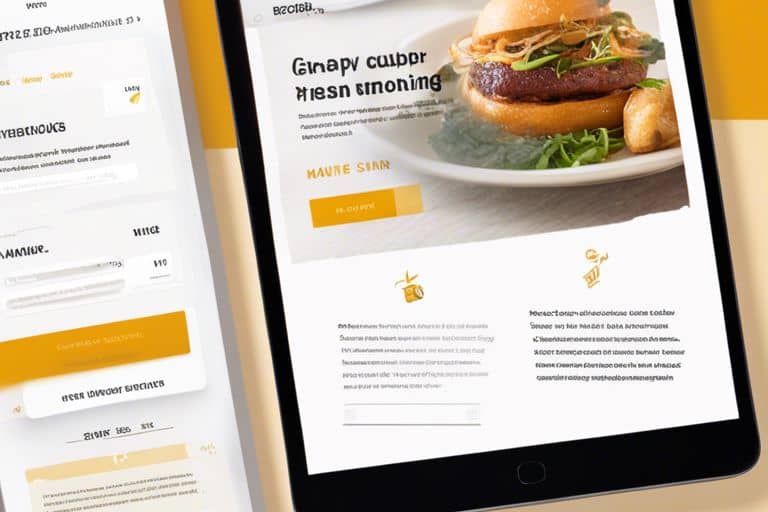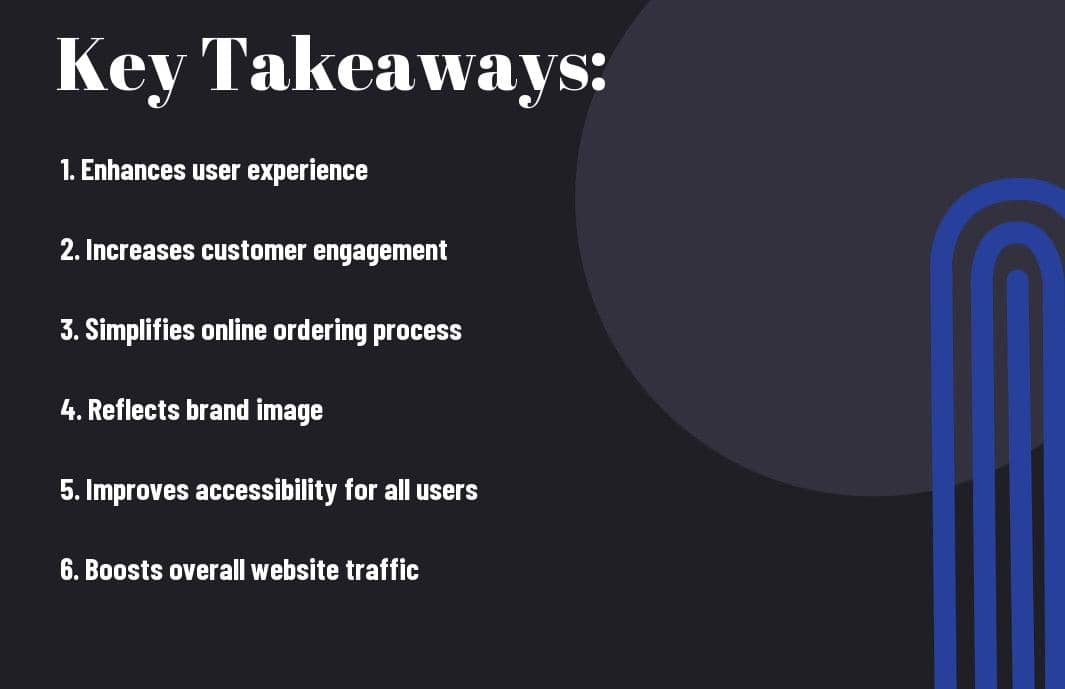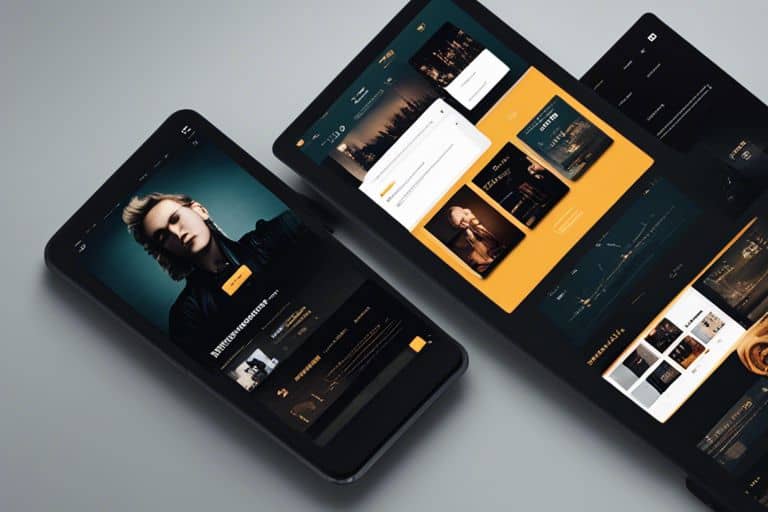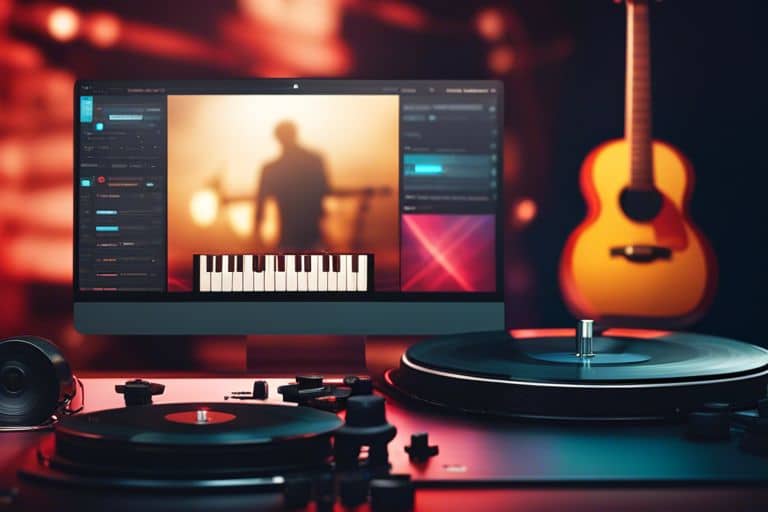
It’s no secret that in today’s digital age, having a strong online presence is crucial for restaurants to thrive. One key aspect that can make or break a restaurant website is its user-friendly interface. A well-designed user interface can enhance the overall customer experience, making it easier for users to navigate the site, browse the menu, make reservations, and ultimately convert visitors into loyal customers. In this blog post, we will explore the importance of a user-friendly interface in restaurant web design and how it can impact the success of your business.
Key Takeaways:
- User-friendly interface is crucial in restaurant web design to enhance the customer experience and encourage more interaction.
- Intuitive navigation helps customers easily find crucial information such as menu, location, and contact details, leading to improved user satisfaction.
- Mobile responsiveness is crucial for restaurant websites as users frequently access them on mobile devices; ensuring a seamless experience across all platforms is key.

Sizzle Like a Steak: Importance of User Interface in Web Design
Some say that in the world of restaurant web design, having a user-friendly interface is like having the perfect seasoning for a steak – it enhances the overall experience and leaves a lasting impression on the diners. A well-designed user interface can make all the difference in capturing the attention of potential customers and keeping them engaged on your website.
First Bite is with the Eye: Visual Appeal
Importance of visual appeal cannot be overstated when it comes to restaurant web design. A visually appealing interface is like a perfectly seared steak – it tempts the senses and makes customers eager to explore further. From high-quality images of delicious dishes to a cohesive color scheme that reflects the restaurant’s brand, every visual element plays a crucial role in creating a captivating user experience.
With respect to restaurant websites, first impressions matter. A visually appealing interface can draw visitors in and entice them to learn more about the menu offerings, ambiance, and special promotions. By investing in professional photography, clean design elements, and a user-friendly layout, restaurants can effectively showcase their unique identity and stand out in a crowded online landscape.
Smooth as Butter: Navigation and Ease of Use
Steak should be juicy and tender, just like the navigation of a restaurant website should be smooth and effortless. Easy navigation is key to ensuring that customers can quickly find the information they need, whether it’s browsing the menu, making a reservation, or checking out special events. A user-friendly interface with intuitive navigation can enhance the overall user experience and encourage visitors to explore all that the restaurant has to offer.
With the rise of mobile browsing, it’s more important than ever for restaurant websites to prioritize responsive design and mobile-friendly navigation. By optimizing the user interface for different devices and screen sizes, restaurants can ensure that customers can easily access their website on the go and make reservations or place orders with just a few taps. Do not forget, in today’s fast-paced digital world, convenience is key!
Tech & Taste: Integrating Modern Features
After establishing the importance of user-friendly interface in restaurant web design, it’s time to investigate into the technological features that can enhance the dining experience for both customers and restaurant owners. In today’s digital age, integrating modern tech features into a restaurant’s website can make a significant difference in attracting and retaining customers.
Reservation Revolution: Online Booking Systems
Online reservations have revolutionized the way customers interact with restaurants. With the click of a button, diners can easily book a table at their preferred time without having to pick up the phone. Implementing an online booking system not only streamlines the reservation process but also helps restaurants manage their seating capacity more efficiently. This feature not only saves time for customers but also reduces the chances of human errors in reservation management.
Menu Madness: Digital Menus and Ordering
Features like digital menus and online ordering have become indispensable in the restaurant industry. Digital menus allow customers to browse through an interactive menu with mouth-watering images and detailed descriptions of each dish. Online ordering takes convenience to the next level, enabling customers to place their orders for dine-in or takeout directly through the website or mobile app. This feature is not only convenient for customers but also helps restaurants increase their efficiency in order processing.
Online ordering has become increasingly popular, especially in the wake of the COVID-19 pandemic, where contactless transactions are preferred. By offering this feature, restaurants can cater to tech-savvy customers who prefer the convenience of placing their orders online. Additionally, online ordering can help restaurants upsell their menu items and increase their average order value.
Feedback is King: Interacting with Patrons
Unlike traditional brick-and-mortar restaurants, online platforms allow for direct and immediate interaction with patrons. This level of engagement is a game-changer when it comes to understanding customer preferences and improving the overall dining experience.
Reviews to Refine: Using Customer Feedback
Customer reviews are like gold dust for restaurant owners. Pay close attention to the feedback provided by your patrons as it can offer valuable insights into what is working well and what needs improvement. Whether it’s through social media comments, online reviews, or feedback forms on your website, use this information to refine your menu, service, and overall customer experience.
By actively listening to customer feedback and implementing necessary changes, you not only show that you value your patrons’ opinions but also create a better dining experience that keeps them coming back for more.
Dishing Out Deals: Promotions and Loyalty Programs
Refine your restaurant’s marketing strategy by dishing out deals that cater to your loyal customers. Loyalty programs, special promotions, and discounts are great ways to reward those who keep coming back for more. Incentivize repeat business and encourage new customers to give your restaurant a try by offering irresistible deals that showcase your menu and service.
With the rise of online food delivery services and fierce competition in the restaurant industry, standing out and retaining customers is more important than ever. Implementing promotions and loyalty programs not only drive sales but also foster a sense of community and loyalty among your patrons.
Full Plate: Responsive and Mobile Friendly Design
Your restaurant’s website is like a virtual menu that showcases your offerings, ambiance, and service. In this digital age, having a website that is not only visually appealing but also user-friendly across all devices is crucial. Responsive and mobile-friendly design is the key to ensuring that your potential customers have a seamless experience when visiting your site.
On-the-Go Orders: Optimizing for Mobile Users
Responsive design ensures that your website adapts to different screen sizes, making it easy for customers to navigate and place orders on their mobile devices. With more people relying on their smartphones for quick searches and food orders, it’s important to cater to this on-the-go audience. Mobile-friendly design elements such as larger buttons, streamlined menus, and simplified checkout processes can help increase conversion rates and drive more business to your restaurant.
Mobile optimization is not just about making your site look good on phones – it’s also about ensuring fast load times. Customers on the move don’t have time to wait for a slow website to load. In fact, studies show that 53% of mobile users will abandon a website if it takes more than 3 seconds to load. By optimizing your website for speed, you can provide a better user experience and keep potential customers engaged with your content.
Fast Service: Website Load Times
Mobile optimization is crucial for any restaurant website, especially when it comes to load times. A speedy website is important for retaining customers and driving conversions. In the competitive world of food service, every second counts. Make sure your website is optimized for speed to keep up with the fast-paced demands of today’s digital consumers. Note, a fast website equals happy customers, and happy customers are more likely to return for seconds.
Conclusion
So, in the world of restaurant web design, a user-friendly interface plays a pivotal role in attracting and retaining customers. An intuitive layout, easy navigation, and visually appealing design can make all the difference in creating a positive user experience. Keep in mind, your website is often the first point of contact with potential diners, so make it count by prioritizing user-friendly design that enhances customer engagement and drives conversions. Stay focused on making the user journey as seamless and enjoyable as possible to leave a lasting impression and encourage repeat visits.
FAQ
Q: Why is a user-friendly interface important in restaurant web design?
A: A user-friendly interface is crucial in restaurant web design because it directly impacts the user experience. When customers visit your website, you want them to easily navigate through your menu, find your contact information, and make reservations without any hassle. A user-friendly interface ensures that visitors have a seamless and enjoyable time interacting with your site, which can lead to increased customer satisfaction and loyalty.
Q: How can a user-friendly interface enhance the branding of a restaurant?
A: A user-friendly interface can enhance the branding of a restaurant by creating a positive impression on visitors. When customers have a smooth and intuitive experience on your website, it reflects well on your restaurant’s professionalism and attention to detail. A well-designed interface that is easy to use can also help reinforce your brand identity and values, making it more memorable for customers.
What are some key elements of a user-friendly interface in restaurant web design?
A: Some key elements of a user-friendly interface in restaurant web design include clear navigation menus, a responsive layout for mobile devices, visually appealing images of food and ambiance, easy-to-read fonts, and accessible contact information. Additionally, incorporating features like online ordering, reservation forms, and customer reviews can further enhance the user experience and make it convenient for visitors to interact with your restaurant online.
Continue reading
Purely you





Leave a Reply